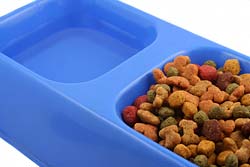
Choosing the Right Dog Food
Posted by admin on June 16, 2010
For many of us humans, it’s pretty easy for us to tell others what our favorite food happens to be and we have so many choices. From different ethnic varieties to the choice of vegetarian or meat dishes it makes shopping for the ingredients fairly easy for us. But, when it comes to feeding our companions, other than their pushing away a bowl or failing to eat a meal, it can be difficult for us to know what our dogs like or don’t enjoy. Of course, what we feed them is probably one of the most important decisions we need to make on behalf of our pets.
When choosing the right dog food for our pets, there are several factors that need to be taken into consideration. Just as with human children, it’s important to not only choose what they enjoy eating, but foot that is rich in nutrients and is good for them as well. As you look over the rows and rows of dog food choices at your favorite pet supply store or supermarket, here are some of the things you should consider when picking the right dog food.
- Recommendations/Advice. By far, the easiest and fastest way to decide what to feed your dog is to ask an expert. The breeder you received your puppy from is an excellent source for determining which food is right for your new best friend. If you forgot to ask, your veterinarian should be your next call. Professional pet healthcare providers and reputable breeders keep up-to-date information on pet food and which ones are best for your dog. Be sure to give them an idea of your budget and they should be able to give you a range of suggestions that can get your started on your search for the perfect food.
- Price. Unless you’re Donald Trump or Bill Gates, how much we pay for something usually always plays a role in our buying decisions and when it comes to pet food it’s usually the same. As with all of your spending decisions, it’s important to establish a baseline of what you can afford to spend each month to help you start the process of buying dog food and the many options you have before you.
- Age. The nutritional needs of puppies, adult dogs and those in their mature years are all different and as such, dog food manufacturers have done an excellent job formulating brands to meet those needs. It’s important to match the specific brand of dog food to your pet and match it to the age. It’s also important not to feed dog food labeled as “puppy” to an adult because it is typically much higher in protein, fat and other ingredients which work well for growing puppies, but not so great for fully-grown adult dogs.
- Breed. Your puppy’s breed should be a key part of choosing what food is best to feed them. Many brands of dog food today are specially formulated not only for the age of your companion, but for specific breed and eventual physical size of the dog. Larger breed dogs such as Labradors, German Shepherds, Irish Wolfhounds and Great Danes can be susceptible to bone and joint health problems like hip dysplasia, so having food that is rich in glucosamine and other ingredients rich in calcium may be good for them.
- Dry vs. Wet Food. This topic alone is liable to generate the most fervent and emotional discussion among dog breeders, vets and caregivers. There are many that say one or the other is better for your companion for various reasons. Hard food can help a dog’s tooth care and help with the animals need to chew and nibble, and hard food has less water content. Soft food is excellent for older dogs that have difficulty chewing or the more finicky eaters and it typically uses much less filler than dry food.
- Read the Labels. When looking at dog food brands, the first stop should always be to read the ingredients label. Sometimes it’s difficult to get past the bright colours, the cute pictures of puppies on the label or the flashy marketing messages, but resist those urges and check the boring label first. Ingredients are listed in the order of what is most in the product. Do your best to avoid products where food fillers such as grains like wheat and corn are listed first. While they help make up the content and size of kibble, they don’t really help your pet other than giving them the feeling that they are “full.” Dogs are essentially carnivores… meat eaters; ideally you want products where proteins and meats are listed first. Avoid chemicals and preservatives. Another “buzzword” to try and avoid is the term “by-products.” This means that the food is made up of items such as the ears, hooves and other parts of animals that aren’t typically used in human consumption. (Peter: I’m a firm believer in the most important factor being how to read the label and perhaps we should put it first, not last. What about a link to a serious dissertation on reading a pet food label, such as http://www.fda.gov/cvm/petlabel.htm?)
Overall, nutrition is as critical for your companion as it is for you. Just as we hope you make smart and healthy food choices for yourself (low in saturated fats, sugars and chemicals and higher in nutritional vitamins and fibers.) The food you feed your pet can directly lead to a healthy, vibrant dog, but it could also lead to medical troubles and possibly disease so it is probably one of the most important decisions you will make on behalf of your friend.


